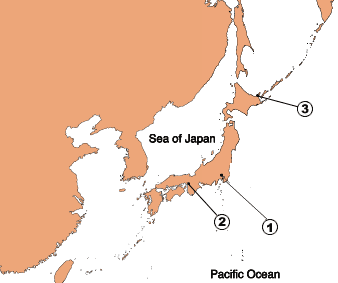| Web Japan > NIPPONIA No.35 > Japan Travelogue |
|
|
|
NIPPONIA No.35 December 15, 2005 |
|
Japan Travelogue |
 |
(1)Tokyo
(2)Osaka
(3)Shiretoko
|
|
Hokkaido is the northernmost of the four main Japanese islands and the second largest after Honshu. The Shiretoko Peninsula juts out into the Sea of Okhotsk in eastern Hokkaido. The name comes from “shirietoku,” meaning “Land's End” in the language of Hokkaido's original inhabitants, the Ainu. Mountains around 1,500 meters high form the spine of the peninsula, and the land slopes steeply, leaving very little flat land at all. In the winter, ice floes push south from faraway Siberia and fill the sea around the peninsula.
Shiretoko was added to the UNESCO World Heritage List in July 2005. This natural heritage site has untouched ancient forests and a scenic ice-covered sea in winter. The forests are home to a number of large mammals, including the brown bear and Yezo sika deer. In autumn, salmon and trout swim upriver from the sea to spawn. There are many species of birds, and some migrate from Siberia. These include rare birds of prey, such as Steller's sea eagle, the white tailed eagle, and the largest owl in the world, Blakiston's fish owl. Tourists come to see the many species of sea birds, as well as groups of marine mammals like seals and Steller sea lions.
Visitors to Shiretoko are best to start at Utoro (also known as Shari-cho), on the northwestern coast. The Five Shiretoko Lakes, Kamuiwakka Yu no Taki (Warm-water Falls) and Furepe Falls are some of the attractions nearby. Shari has a number of hotels offering hot spring baths.
Before you start exploring, visit the Shiretoko Nature Center. It has plenty of information for the wilderness enthusiast, and offers plenty of nature activities. One of the staff members, Matsuda Mitsuki, says that Shiretoko got its listing as a World Heritage Site because of its ecosystems and the diversity of its species. He suggests visitors take a guided tour of the area to better understand the local natural environment.
Once outside again, take the trail from behind the Center to Furepe Falls (about 20 minutes). The trail passes through woodlands, then onto grassland that stretches to the sea. Yezo sika deer and their fauns graze without a care in the world. Come and see them in July, when the temperature is mild and there will probably be a pleasant breeze from the Sea of Okhotsk. At the far end of the grassland, near the cliffs, stands a lookout. It is an excellent place to admire the falls nearby, and the magnificent Shiretoko Mountain Range in the distance.
Between the lookout and the Center, you may see brown bears walking slowly out of the woods, perhaps only 50 or 60 meters away. The cubs are cute, but the parents create quite a stir among their human observers, who tend to move on quickly, glancing anxiously behind them.
Once you are back at the Center, take a bus to Kamuiwakka Yu no Taki Falls. The bus will wind along a road for about 50 minutes, then let you off at the starting point for a rather challenging half-hour walk up a valley to the falls (about 1 km). Be careful not to slip—there are a number of boulders to climb over, and spray to pass through, as you climb up the steep side of the river to the pool under the fall. The pool serves as an outdoor bath—the water comes from a hot spring and is just the right temperature for a dip.
Rausu is another town well worth a visit. A bus from Utoro will take you eastward, over the Shiretoko Pass and right across the peninsula (distance, about 30 km; road closed in winter). Rausu is basically a fishing community. There are no large hotels, and you will get the feel of a fishing port in Japan's far north.
Go out to the beach in the morning: you will probably find a strong wind and fishermen unloading and rinsing kombu seaweed. They start gathering it at the first light of day. Kombu grows well along the coasts here, and it is Rausu's best known product. Talk to a fisherman carrying a load of seaweed and he will grin and tell you that during the kombu season, work is especially long and hard. Harvesting it is hard work, but processing it is just as tough. After rinsing it, it has to be dried in the sun on the beach, and then cured. Processing the kombu involves more than 40 steps in all.
The beach at Rausu in the summer will leave you with memories of fragrant kombu and a vibrant fishing port.
|
|
||||||
|